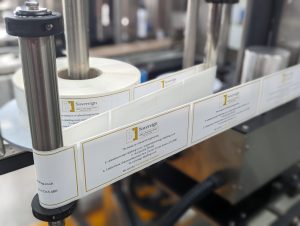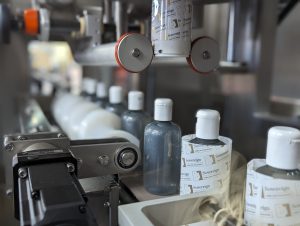Jordan Hynes interview – PPMA Total Show...
Hear from Business Development Manager Jordan Hynes as he speaks to Automate UK, live from our stand (G10) during PPMA...
Posted on 10 August 2025 by Thomas Glendinning
When you’re considering how best to decorate bottles, cans, and other containers, you might be wondering whether labels or shrink sleeves are the right option for you.
With both having an important role to play in the consumer goods value chain, knowing which is right for you and why is paramount.
Pressure sensitive adhesive (PSA) labels are one of the most common forms of product decoration.
They are a versatile and highly effective means of delivering impactful branding and consumer engagement. They can be filmic or made of paper, with the latter growing in importance in today’s sustainability-orientated world. Developments in the adhesives used is improving how PSA labels can be effectively removed during recycling processes so as not to negatively impact the quality of the recovered recyclate.
The importance of pressure-sensitive labels extends beyond branding and retail visibility. Their superior print quality enables sharp graphics, barcodes, and variable data printing to support supply chain efficiency and traceability. In highly regulated sectors such as pharmaceuticals, PSA labels ensure accurate dosing instructions and provide tamper-evident features, protecting both consumers and brands.
From a manufacturing perspective, pressure-sensitive labels streamline operations by reducing application times, minimising waste, and ensuring consistency across high-speed production lines.
The durability of PSA labels will be impacted by the surface they are applied to, the label’s own material, the type of adhesive used (permanent or removable), and the condition of the surface the label will be placed on. Typically, these labels work best on glass or metal and are applied to flat, smooth surfaces.

Pressure-sensitive labels are applied at speed, requiring accurate and pin-point placement
Label adhesion is achieved through the application of pressure – the clue is in the name – so that the label sticks securely to the desired surface. This type of label is most often applied at high speed, meaning it is essential that they are applied accurately and with pin-point precision. This makes highly engineered labelling systems with tight tolerances essential to anyone thinking about adopting pressure-sensitive labels as their decoration technique of choice.
PSA labels are considered to be one of the most cost-effective and efficient means of product decoration. They are straightforward to print and do not require any extra adjustments to be made to the artwork.
If you are looking for a simple yet effective way to decorate products, labelling could be perfect for you.
But if your products require a little something different, sleeving is another option.

Sleeves slip over a container and are then stretched or heated to fit snugly to the object’s shape
Sleeve labels are pre-printed films that are formed into hollow cylinders (sleeves) that are slipped over a container before being formed to an object’s shape by stretching or heating the label.
This creates a seamless and eye-catching finish and makes sleeves ideal for industries such as beverages, food, cosmetics, pharmaceuticals, and household products, where differentiation and shelf appeal are critical.
Sleeve labels do not use any adhesive, making them completely safe for food environments. These labels are applied with a dedicated sleeve labelling machine, which can automate the process and guarantee 100% accuracy every time.
For brand owners, the importance of shrink sleeves lies in their versatility. They work with complex container shapes, allowing for bold graphics, vibrant colours, and high-quality finishes that maximise visual impact. They also offer functional benefits such as tamper-evident seals that contribute to consumer safety and ensure product integrity.
There are three different types of machines when it comes to sleeving. These depend on the end result of your product and are: shrink sleeving machines, full body sleevers, and heat shrink sleeving machines.
Sleeve labels are generally considered more durable than adhesive labels. They can be used in moist and humid environments, including the shower and refrigerator, without fear of coming unstuck. Another interesting feature is that the design is printed on the reverse side of the film, making it resistant to heat, scratches, UV light, humidity, and chemicals.
Work is ongoing in the supply chain to improve the sustainability of sleeves. This includes a new generation of materials that can be easily recycled and the use of integrated perforation strips as part of the sleeve’s design to make removal from the container easy once the product reaches the end of its life. Some clever brands even make the perforations look like zippers, reinforcing the message.
The biggest benefit of using sleeve labels is the 360-degree coverage they provide on containers of any shape. Heat shrink labels particularly allow the sleeve to shrink into every nook and cranny of the product, meaning there is more room for brand visibility and marketing information.
While the design has to be adjusted for distortions using software during the artwork origination stage, this additional step yields as much as 150% more labelling real estate.
This makes sleeving and sleeve labels a great investment if you are looking to create a full coverage, sleek finish for all your products.
If you are still unsure whether labelling or sleeving is right for you, contact us to discuss your needs.
We have machines that can service both styles of product decoration and vast experience helping brands and co-packers find the right machine for their needs!
Interested in Sovereign Labelling adding its trusted and proven engineering expertise to your machine labelling requirements?
Get in touch today and we will be back to you quickly to discuss how our meticulous attention to detail can bring engineering innovation to your business.